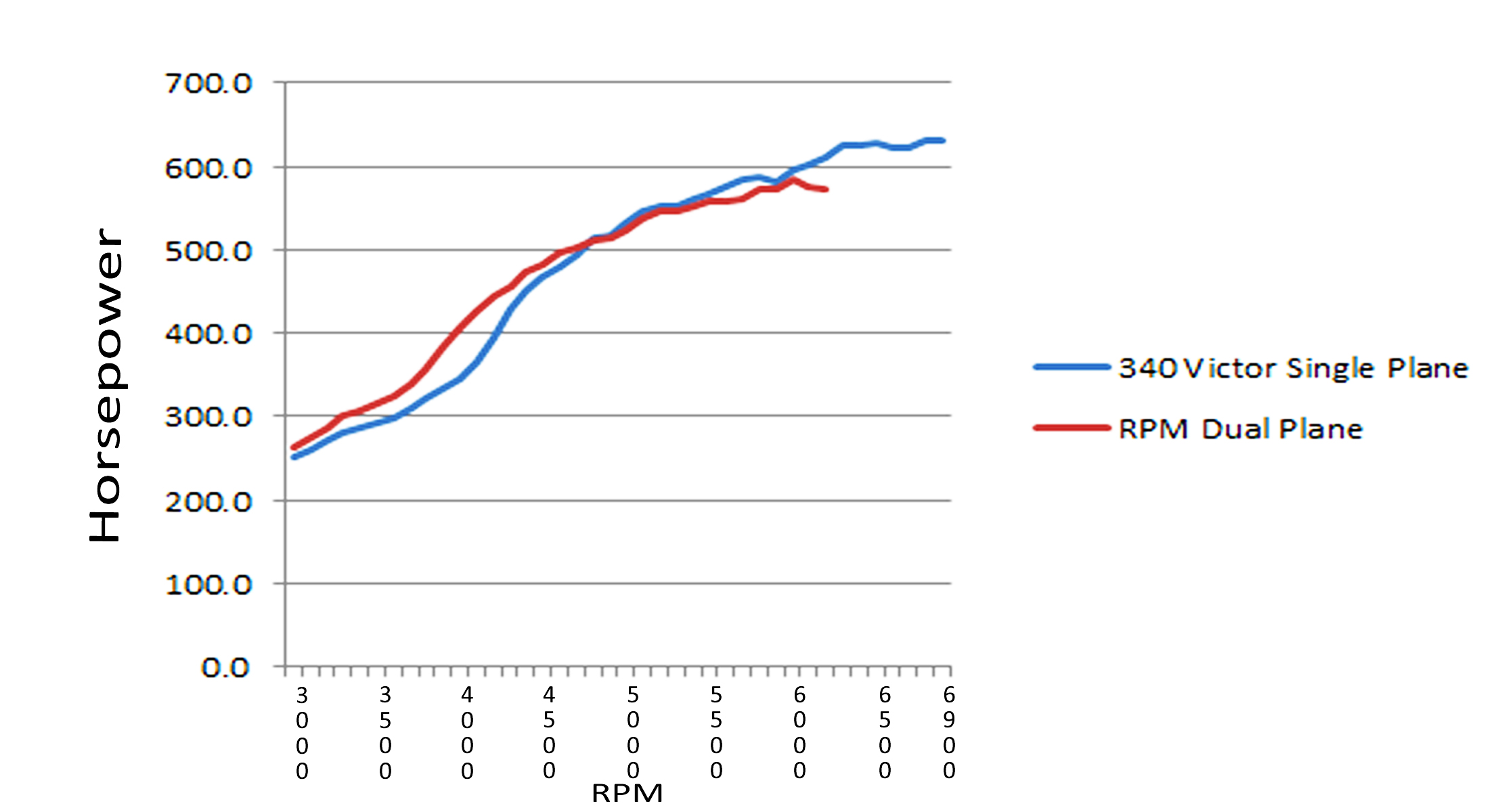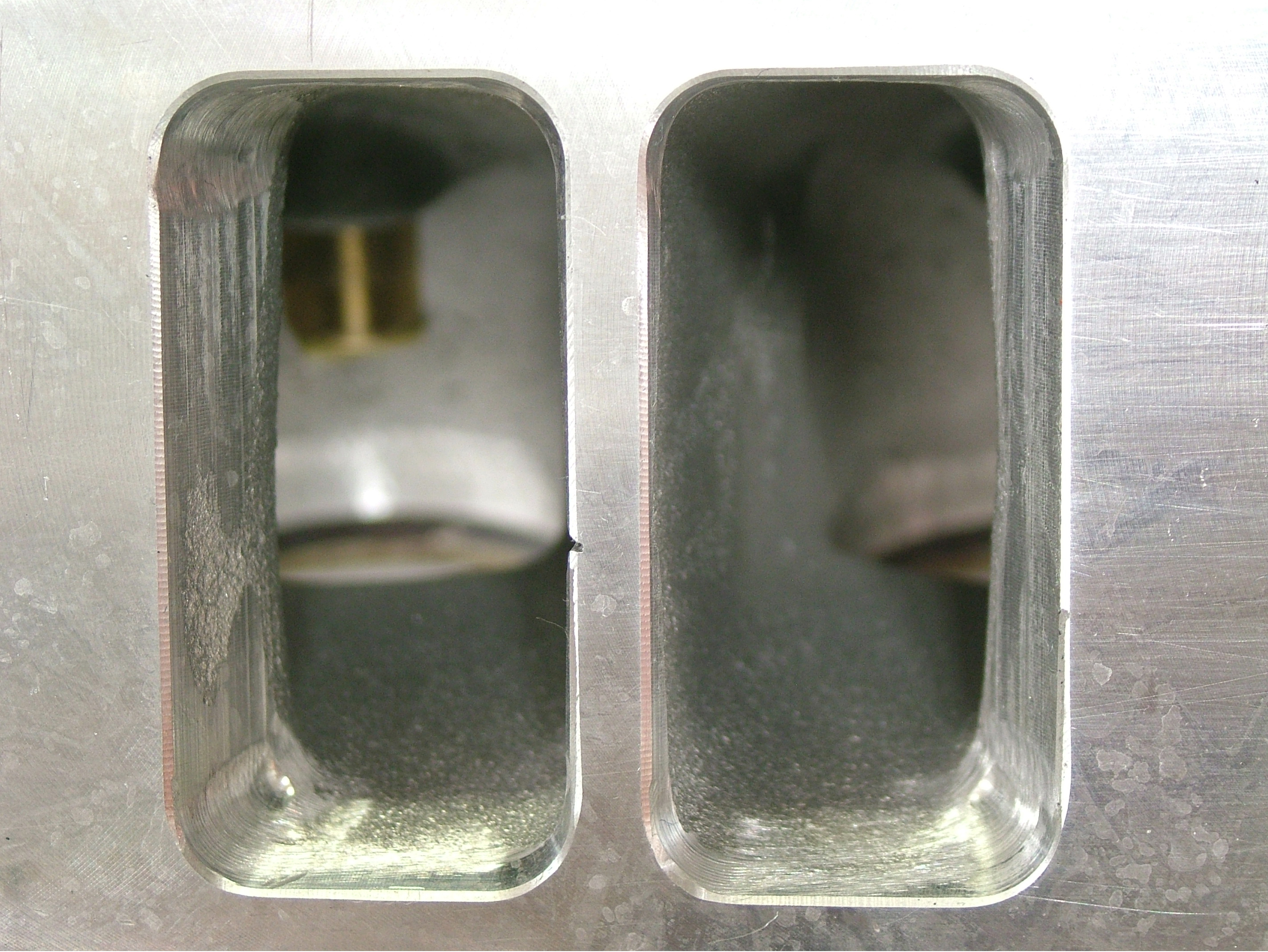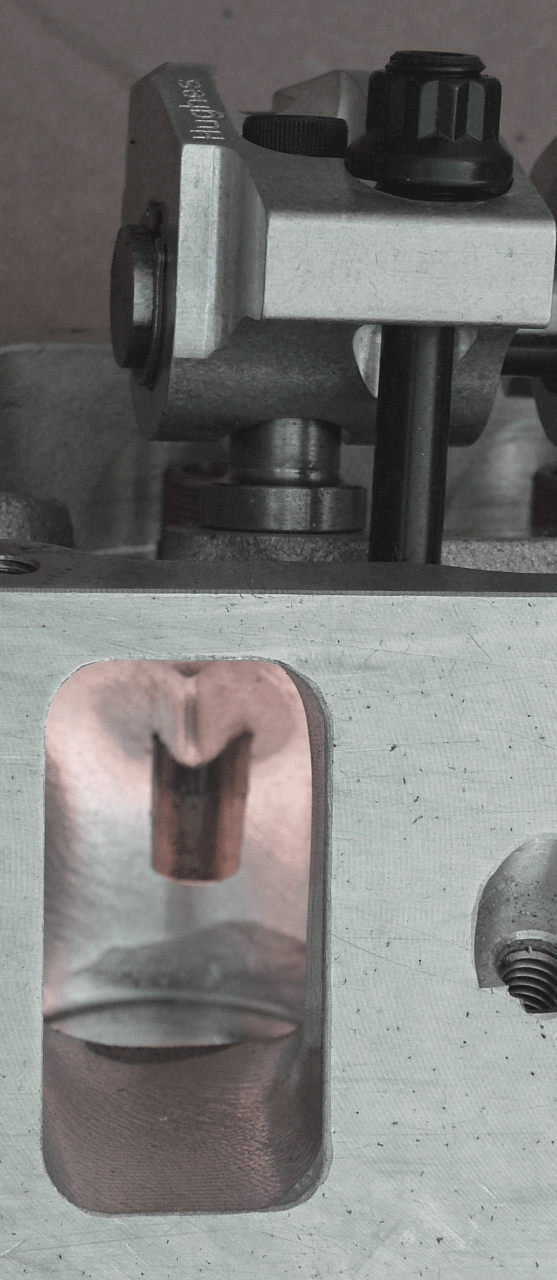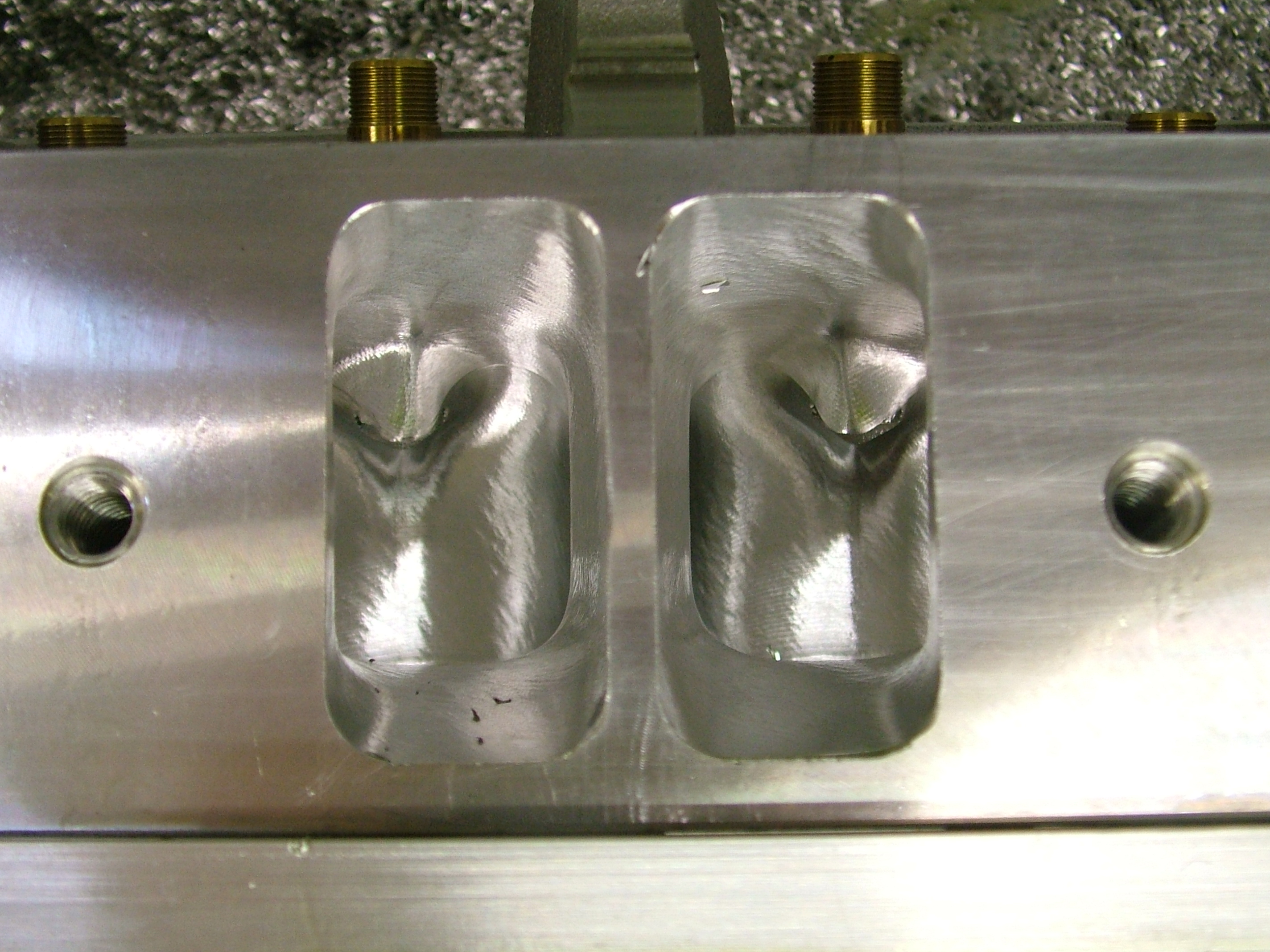|
|
#11---Smallblock Big Mouth Ports on the Dyno | 1/10/2022 |
Small Block - Big Mouth Ports (Tested June 2012) (updated August 2019)
This tech article is to show the power gains with BigMouth intake ports over our standard full CNC Stage 3 ports. The tests show how much power difference the large ports make even more power with a less agressive engine build-up.
These 3 dyno tests show two different things.
Test 1: The difference the larger port volume of the BigMouth ports makes over a more agressively built engine
Test 2: The power and torque differences between a single plane and dual plane intake on the same engine.
----------------------Comparitive Dyno Tests--------------------
|
Big Engine "Engine A"
|
|
Small Engine "Engine B"
|
|
|
|
|
|
|
|
|
|
|
|
|
|
|
|
|
Big Engine /Standard Ports
|
|
Small Engine/Bigmouth Ports
|
|
|
|
|
|
|
|
|
|
|
|
4.080" Bore
|
|
4.030" Bore
|
|
|
|
|
4.00" Stroke
|
|
4.00" Stroke
|
|
|
|
|
418 Cubic Inches
|
|
408 Cubic Inches
|
|
|
|
|
14.4:1 Compression Ratio
|
|
11.5:1 Compression Ratio
|
|
|
|
|
Standard 195cc intake port volume with standard pushrod location Our Standard Stage 3 CNC port
|
|
"BigMouth" 206cc intake port volume with pushrod moved over .200" *
Current BigMouth heads pushrods are moved over .350"
|
|
|
|
|
Camshaft: HTL6872AS-6
|
|
Camshaft: HTL 6468AS-6
|
|
|
|
|
1.6: ratio offset rockers
|
|
1.6:1 ratio offset rockers
|
|
|
|
|
Edelbrock Super Victor w/ competition porting work
|
|
Edelbrock Super Victor w/ competition porting work
|
|
|
|
|
AED 1000 (Custom built) Carburetor
|
|
850 Holley (stock) Carburetor
|
|
"BigMouth" Small Engine Advantage
|
|
114 Octane Race Gas
|
|
92 Octane Pump Gas
|
|
|
RPM
|
Torque
|
HP
|
|
Torque
|
HP
|
|
Torque
|
HP
|
|
3000
|
|
|
|
442.3
|
252.7
|
|
|
|
|
3100
|
|
|
|
441.0
|
260.3
|
|
|
|
|
3200
|
403.8
|
246.0
|
|
446.4
|
272.0
|
|
+43
|
+26
|
|
3300
|
401.9
|
252.5
|
|
446.5
|
280.6
|
|
+45
|
+28
|
|
3400
|
401.8
|
260.1
|
|
441.4
|
285.7
|
|
+40
|
+25
|
|
3500
|
398.9
|
265.8
|
|
436.8
|
291.1
|
|
+47
|
+26
|
|
3600
|
401.3
|
275.1
|
|
436.4
|
299.1
|
|
+35
|
+24
|
|
3700
|
405.7
|
285.8
|
|
440.5
|
310.1
|
|
+35
|
+25
|
|
3800
|
421.7
|
305.1
|
|
442.5
|
320.5
|
|
+21
|
+15
|
|
3900
|
423.2
|
314.2
|
|
449.4
|
333.7
|
|
+26
|
+19
|
|
4000
|
434.4
|
330.8
|
|
453.1
|
345.1
|
|
+19
|
+15
|
|
4100
|
456.8
|
356.6
|
|
468.5
|
365.7
|
|
+12
|
+9
|
|
4200
|
470.0
|
375.8
|
|
494.3
|
395.3
|
|
+24
|
+20
|
|
4300
|
534.3
|
437.5
|
|
525.4
|
430.1
|
|
-9
|
-7
|
|
4400
|
532.8
|
446.4
|
|
536.0
|
449.1
|
|
+4
|
+3
|
|
4500
|
547.0
|
468.7
|
|
546.7
|
468.4
|
|
0
|
0
|
|
4600
|
547.0
|
479.1
|
|
547.4
|
479.4
|
|
0
|
0
|
|
4700
|
547.5
|
489.9
|
|
551.1
|
493.2
|
|
+4
|
+4
|
|
4800
|
559.7
|
511.5
|
|
561.2
|
512.9
|
|
+2
|
+1
|
|
4900
|
566.7
|
528.7
|
|
555.0
|
517.8
|
|
-11
|
-9
|
|
5000
|
564.7
|
537.6
|
|
557.7
|
531.0
|
|
-7
|
-6
|
|
5100
|
565.6
|
549.2
|
|
547.7
|
545.4
|
|
-18
|
-4
|
|
5200
|
563.9
|
558.3
|
|
545.2
|
551.5
|
|
-18
|
-7
|
|
5300
|
555.8
|
560.9
|
|
541.2
|
552.7
|
|
-14
|
-8
|
|
5400
|
552.9
|
568.5
|
|
538.3
|
560.6
|
|
-14
|
-8
|
|
5500
|
539.9
|
565.4
|
|
536.9
|
566.8
|
|
-3
|
+1
|
|
5600
|
526.7
|
561.6
|
|
530.3
|
574.0
|
|
+4
|
+13
|
|
5700
|
525.8
|
570.7
|
|
516.9
|
582.7
|
|
-9
|
+12
|
|
5800
|
523.3
|
577.9
|
|
522.3
|
585.7
|
|
-1
|
+8
|
|
5900
|
513.3
|
576.6
|
|
517.8
|
580.6
|
|
+4
|
+4
|
|
6000
|
509.4
|
582.0
|
|
516.5
|
596.7
|
|
+7
|
+14
|
|
6100
|
504.0
|
585.4
|
|
520.4
|
601.4
|
|
+16
|
+16
|
|
6200
|
498.6
|
588.6
|
|
512.2
|
609.7
|
|
+20
|
+21
|
|
6300
|
496.6
|
598.1
|
|
506.8
|
624.2
|
|
+8
|
+26
|
|
6400
|
494.2
|
602.2
|
|
494.9
|
624.2
|
|
0
|
+22
|
|
6500
|
481.3
|
595.7
|
|
488.3
|
627.2
|
|
+7
|
+32
|
|
6600
|
|
|
|
497.5
|
621.9
|
|
|
|
|
6700
|
|
|
|
479.4
|
623.0
|
|
|
|
|
6800
|
|
|
|
442.3
|
631.2
|
|
|
|
|
6900
|
|
|
|
441.0
|
629.8
|
|
|
|
As you can see, the big engine with the standard 195cc ports had all the advantages except for port volume:
- 418-vs-408 cubic inches
- 14.4:1-vs-11.5:1 compression (Race gas-vs-pump gas)
- Larger cam (* During testing 2 larger cams were tried on the big engine with no power improvement)
- Super Victor competition ported intake-vs-340 Victor competition ported intake
- 1000cfm custom carb-vs-box stock 850 Holley carb
But, it still had less power than the smaller 408 cubic inch engine with the Largemouth Edelbrock heads and much milder parts….29HP less! If we had installed these Largemouth heads on the bigger engine it should have made well over 675hp.
Single plane intake -vs- Dual plane intake
The charts below shows the torque and horsepower advantages between the two intakes used in the dyno test shown above. What is plain to see is that up to 4800rpm the dual plane intake is much stronger and from 4800 up to 6000 it is pretty much a trade-off. In other words, if you don't stay above 6000 rpm the dual plane is the best way to go. Obviously the horsepower and torque numbers are not going to be as high on a milder engine build but the performance differences will remain relative.
Click on either chart to enlarge.
Horsepower Torque
 
Now the next question to be asked and answered is how are you going to use your engine? If it is street up to 80% of the time, the dual plane will be your best choice. If it is 50/50 street/strip, you have tough question and know neither manifold is perfect for a 50/50 engine. If it is a 4 speed or a high stall automatic (3800/4000) and you're going to be shifting at 6500rpm+, the single plane would be your best choice. And get a trailer! You will probably need it.
Special Test:
We tried a competition ported Edelbrock RPM dual plane intake with the same 850cfm carb. Obviously it cannot flow the air of either of the single planes, but it represented itself very well with 583hp and 576 lb/ft of torque. But look at the lower RPM torque versus the single plane intakes. The small engine made more torque with the RPM intake rthan the big engine. Especially at the low end, 67 lb.ft more.
Chart shows torque increase with RPM Dual Plane Intake Over a Single Plane Intake
|
RPM
|
Big Engine
|
Small Engine
|
|
3300
|
+76 lb/ft
|
+31 lb/ft
|
|
4000
|
+100 lb/ft
|
+81 lb/ft
|
|
4400
|
+31 lb/ft
|
+37 lb/ft
|
To view the flow chart for this head click the button below.
 What these test show is the need for more port volume on these larger cubic inch engines enabling them to make maximum power. What we did was plug the original pushrod holes and move the pushrod over .200” and then use .200” offset rocker arms. The port opening was CNC’d to the Largemouth configuration. This operation can be performed on any existing small block Edelbrock RPM cylinder head. But now we move the pushrod over .350" for a "BIG MOUTH" port with more port volume and air flow. To complete the conversion you will need is our 4 LH and 4 RH intake rocker arms and slightly longer 3/8" pushrods. Give us a call!
Jan 2013 update: We are now moving the pushrods over .350" on LA heads and .420" on the Magnum heads. We have 1.6 ratio rockers for both applications and the big port heads are both called "Big Mouth". And, we can retro-fit your existing heads to Big Mouth. Check out our listings in the appropriate sections of our website.
* The "Big Mouth" ports both LA & magnum are now 225cc.
Offset Rocker
 
Standard Ports BigMouth Ports
 
|
|
| | Home | Phone: 309-745-9558 | Email: information@hughesengines.com |



